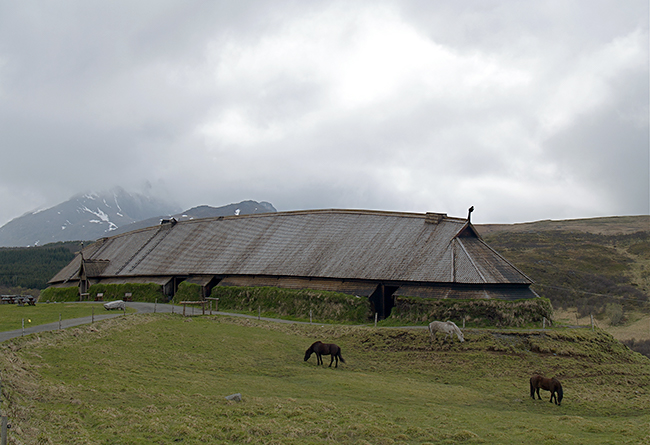
Lofoten is an archipelago off the north-west coast of Norway, just inside the Arctic Circle. It has an incredibly diverse landscape that includes both huge towering mountains, covered in snow, and beautiful white, sandy beaches with cerulean blue waves lapping at the shore.
Today, it can take three flights to reach Lofoten from London and, once on the Norwegian archipelago, it can feel as though you are on the edge of the world. But in the Viking era, it was quite the opposite: the islands were actually knitted into trade, social, business and political networks that spread right across northern and western Europe.
In fact, Lofoten was home to the biggest Viking house that has ever been found. Uncovered by archaeologists on the island of Vestvågøy in 1983, this longhouse is thought to have belonged to successive Lofoten chieftains. A reconstruction has since been built 40 metres from the excavation site, and forms part of the Lofotr Viking Museum.
This article is an edited transcript of Vikings of Lofoten on Dan Snow’s History Hit, first broadcast 16 April 2016.
The biggest Viking house ever found

The reconstructed longhouse that forms part of the Lofotr Viking Museum. Credit: Jörg Hempel / Commons
The excavated remains and the reconstruction reveal the house to be enormous – it measured 83 metres long, nine metres wide and about nine metres high. The building’s size is unsurprising given that it served as the home of the archipelago’s rich and powerful chieftains, with the last occupant believed to be Olaf of Lofoten.
The chieftain would have lived in the house with his family, as well as his most trusted men and women – around 40 to 50 people altogether. But it wasn’t just people who lived there. Half of the house served as a large barn that was home to horses and cows. A gold-plated horse harness was excavated from the site of the original barn – an indicator of the chieftains’ status and wealth.
The original house on the site was built in around 500 AD but later made bigger and longer, and rebuilt and restructured a couple of times. The house on which the reconstruction is based was built in around the year 900 – around 100 years after the start of the Viking era.
At that point, Vikings from Scandanavia were attacking as far as England and Ireland, and on the verge of settling Iceland and even places across the Atlantic Ocean.
Olaf of Lofoten – and Iceland?
The last Viking chieftain to have lived in the house – Olaf – is thought to have left for Iceland, and there is a possible reference to him in one of the Icelandic sagas:
“There came a man from Lofotr, Olaf was his name.”
“Lofotr” was the former name of Vestvågøy but later given to the whole of the island group. In English, however, the archipelago is referred to as “Lofoten”.
To have travelled to Iceland at that time and to have conquered new land, a Viking would have needed to have been rich and powerful. They would have needed a ship, horses and enough money to fund resettling there. As the Lofoten chieftain, Olaf likely would have had all of that. So the chances are very good that he did indeed go to Iceland.
Inside the reconstructed chieftain’s house
The reconstruction enables visitors to get a feel for a Viking chieftain’s house, albeit minus the livestock. Vast and echo-y, it’s a dramatic space and has a sort of grandeur to it. Plastic and metal are nowhere to be seen, with both the building itself and the furniture made of wood.
The walls, meanwhile, are covered with sheep and reindeer skins, giving the building a cosy feel despite its vastness. It’s easy to imagine spending a Viking winter there, coming in from the terrible weather outside when there would have been a fire going, the smell of smoke and tar mixing with the smell of food cooking in the air, and the sounds of craftspeople working all around.
 Listen Now
Listen NowA resourceful people
Whether they were building ships or remarkable buildings like the chieftain’s house on Lofoten, the Vikings proved themselves to be extraordinary craftspeople who were phenomenally good at working with wood, textiles and metal. And they had to be in order to survive some pretty tricky weather.
They also had to make use of the resources that were to hand or relatively easily accessible. Wood wasn’t plentiful on the Lofoten Islands, but the Vikings didn’t have to travel too far by boat in order to import the big trees needed for the kind of work seen at the Lofoten chieftain’s house, which includes huge pillars decorated with beautiful hand-carvings.
When it came to metal work, the Vikings made – among other things – jewellery and sword grips that were rich with ornaments and so detailed that, even if they had been produced today, you might find it hard to believe they were handmade.
Meanwhile, unlike today where we see water as representing a barrier, the Vikings on Lofoten were at the centre of a trading network. As seafarers, they could travel extensively and reach London or central Europe in just a few days; in some respects they were actually at the centre of the world.
Of course, back then, Lofoten was still at the top of the world. But it was a very rich part of the world when it came to resources. So it’s easy to understand why people decided to live there. There was plenty of fish in the sea, as well as other marine life to live off. There would have been game in the forests and lots of other natural resources available that would have been greatly sought after in other parts of the world.














